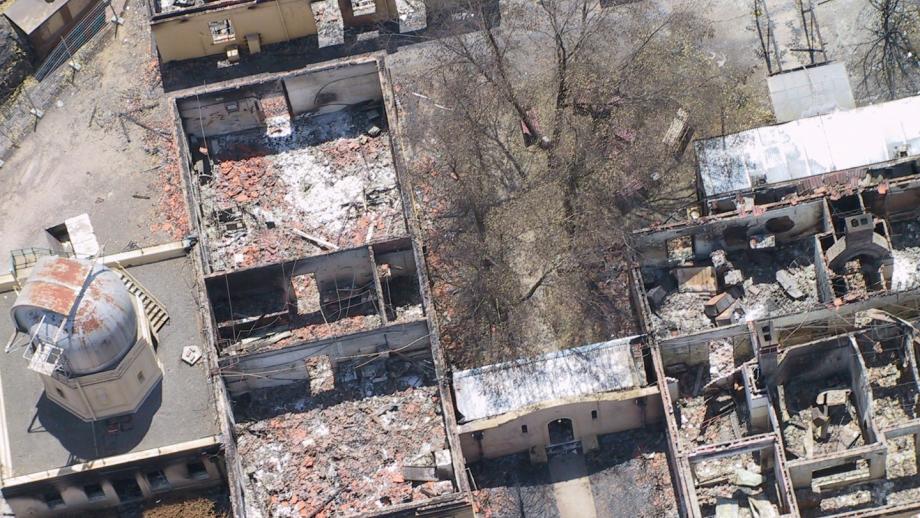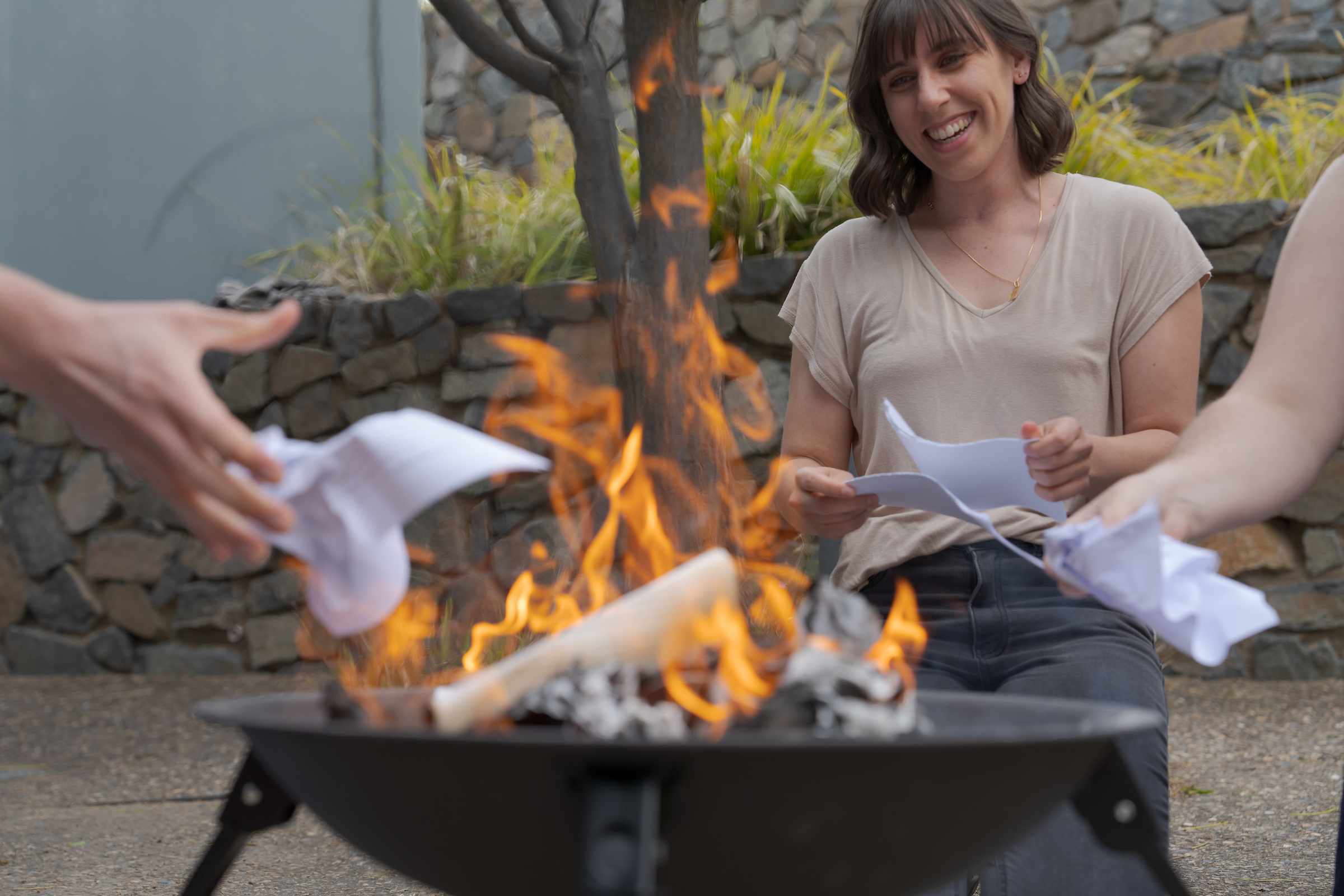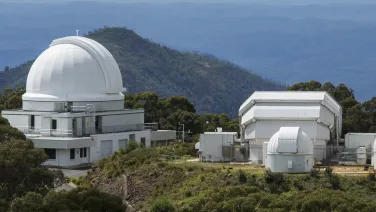
The best words in the best order: why do our astronomy students burn their PhD thesis?
“It was the strangest thing you can imagine,” Professor Ken Freeman says. He is remembering walking through the burnt-out library at the ANU Mount Stromlo Observatory after the 2003 bushfires.
“We had all these bound theses and journals and, after the fire, they were all still there. They were neatly stacked on the shelves. But if you blew on them, they would disintegrate into ash. They were just a shell.”
One of Australia’s most distinguished astronomers, Professor Freeman has spent over 50 years of his career at the ANU Research School of Astronomy and Astrophysics at Mount Stromlo. At the time of the bushfires, his responsibilities included managing the library in the CSO Building, which was, like many of the facilities on the mountain, completely destroyed.
“It was a blow,” he says, of the loss of the collection, including all the theses of former PhD students, but not as much of a blow as it would have been if the fire had happened ten years earlier. By 2003, almost all of the journals had been digitised, if not all the books. “And by the time of the fire, people weren’t using libraries much anymore.”
The contents of the library were not replaced, physically; it’s much easier to hit Ctrl-F on a PDF than to scour hundreds of pages for relevant information about dark matter. We don’t actually need physical copies of books, which are all just shells, really, for the knowledge and work they contain. Now you can get through your whole university career without even consulting one. PhD students are no longer even required to submit a printed, bound thesis. They click a ‘submit’ button on screen.
But there’s something about a physical book. Just like there’s something about the memory of all that knowledge and work being turned to ash.

Caption: CSO Building after the fires, 2003. Credit: Mt Stromlo Archives.
Dr Tania Barone was sitting at home, on her couch, during a two-week stint of quarantine, when she hit the button to finalise her PhD in astrophysics. Little fireworks erupt on screen when it’s all done, which is a nice touch, but this wasn’t the moment, years in the making, she’d been waiting for.
“I want to have the visual representation of my work sitting on my desk,” Dr Barone says. She doesn’t need to, but she’s going to get her thesis printed and bound. “I want to be able to look up and see T. Barone, PhD, and it’s a weighty book that shows the amount of work and effort which went into it.”
And then, she wants to see it all go up in flames.
Dr Barone doesn’t remember anything of the 2003 fires; she was only nine years old. But the legacy of the fires are all over Mount Stromlo, she says, even in the markings on the floor of the rebuilt facilities which show where the old buildings used to be.
“When I started my PhD, everyone in the school knew the history and the memories of the bushfires and that gets passed on.” That’s how Dr Barone found out about the tradition for students at Mount Stromlo, after all the work is done and dusted on their PhD, to set their thesis on fire.
The first burning ceremony was conceived by the generation of students who lived through the fires. It was a way for them to let loose after a stressful few years, and to remember what was lost. Now, 20 years later, students continue the tradition – not if there’s a fire ban, of course – as a gesture of solidarity. “It’s a ‘hats off’ to those former students,” Dr Barone says. “It’s a remembrance.”

Dr Tania Barone on graduation day. Photo: ANU/Nic Vevers.
Along the way, the tradition has been built upon by other students too. “It’s handed down from PhD student to PhD student, so I got indoctrinated,” Dr Simon Murphy says. He’s now an astronomer at UNSW Canberra, but ten years ago, he was writing his thesis at Mount Stromlo, and in need of distraction. This is how he ended up buying an urn.
“I bought it from eBay,” he says, laughing. “You can buy anything from eBay!” The idea behind the urn is that it’s communal and perpetual, for students to contribute to, year after year, with a handful of ashes from their own thesis. It’s on display in the foyer of the CSO Building, right there next to Professor Brian Schmidt’s Nobel Prize.
Dr Murphy also had the urn engraved, at Mr Minit in Woden – “I got some funny looks” – with a stirring quote inspired by Coleridge: “Here lie the best words in the best order”. It’s a humbling idea, that after three years of wrangling and tweaking, it’s only when it’s in the urn, in ashes, that your thesis is finally in its perfect form.
“Is the urn still there?” Dr Murphy asks. It is. “That makes me happy,” he says. “Long may the tradition continue!”

The urn on display at Mount Stromlo. Photo: ANU/Nic Vevers.
It wasn’t just Professor Freeman’s workplace which was damaged by the fires. His home in Duffy was destroyed too, as were 500 others. He lost almost everything, including family heirlooms, and two violins, which he was deeply attached to.
“I still don’t know why I didn’t think to grab them,” he says. He also mourns the loss of the 74-inch telescope at Mount Stromlo, which he was working on right up until he was told to evacuate. You can become attached to a telescope too, he says.
He still has his copy of his PhD thesis though, from 1965. It was in his office, spared by the fire. “I don’t know when I last opened it,” he says. “It must have been decades ago.” Now it just sits there on his bookshelf, alongside the theses written by the 60 PhD students he has supervised since then.
Dr Barone jokes that no-one ever reads your thesis except to give it criticism. Her parents tried to read hers, but it’s strewn with impenetrable mathematical equations. Her research was on galaxies, and how the shape and size of the galaxy relates to the type of stars it has within it. It was a good perspective, she says, for someone with their head stuck in the minutiae of their PhD.
“Anytime I was trying to work late on something, I was like, ‘Well, nothing’s going to change by tomorrow.’ Nothing changes faster than like a billion years in my research.”

Dr Barone's PhD thesis. Photo: ANU/Nic Vevers.
Maybe it will sit untouched for decades on her desk, but her thesis is already doing its job: Dr Barone is now a postdoctoral researcher at Swinburne University, having published several papers from her PhD. After her graduation ceremony, and a celebratory family lunch, there’s only one more thing left to do, and that’s to watch it all turn to dust. She’s not going to burn her beautifully bound thesis though, as some people do, but all her notes and drafts, as a symbol.
“How will it feel?” Dr Barone asks herself. “I don't know. I've been wondering about that. I don't know if it’ll feel cathartic, but I hope it will.”
While completing your PhD, she says, you feel like your thesis matters more than anything else. “I mean, it matters to you, it matters to your supervisor, and it matters to a research group.”
“But sometimes,” she adds, “it’s nice to remember that in the grand scheme of things, it’s not the most important thing in the world. It can be burnt. And that’s okay.”

Dr Barone, with other PhD graduates, as she burns her thesis. Photo: ANU/Nic Vevers.



